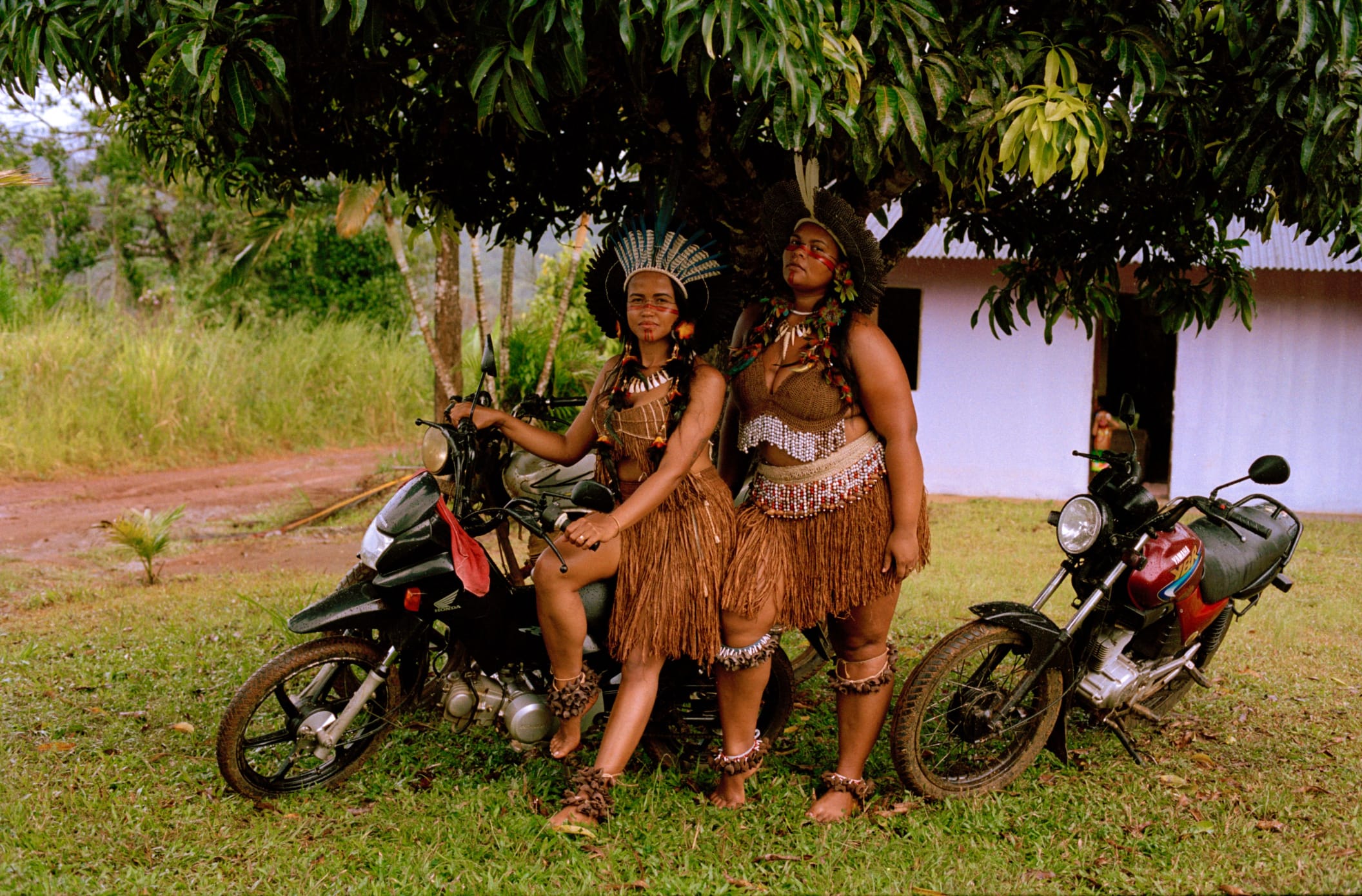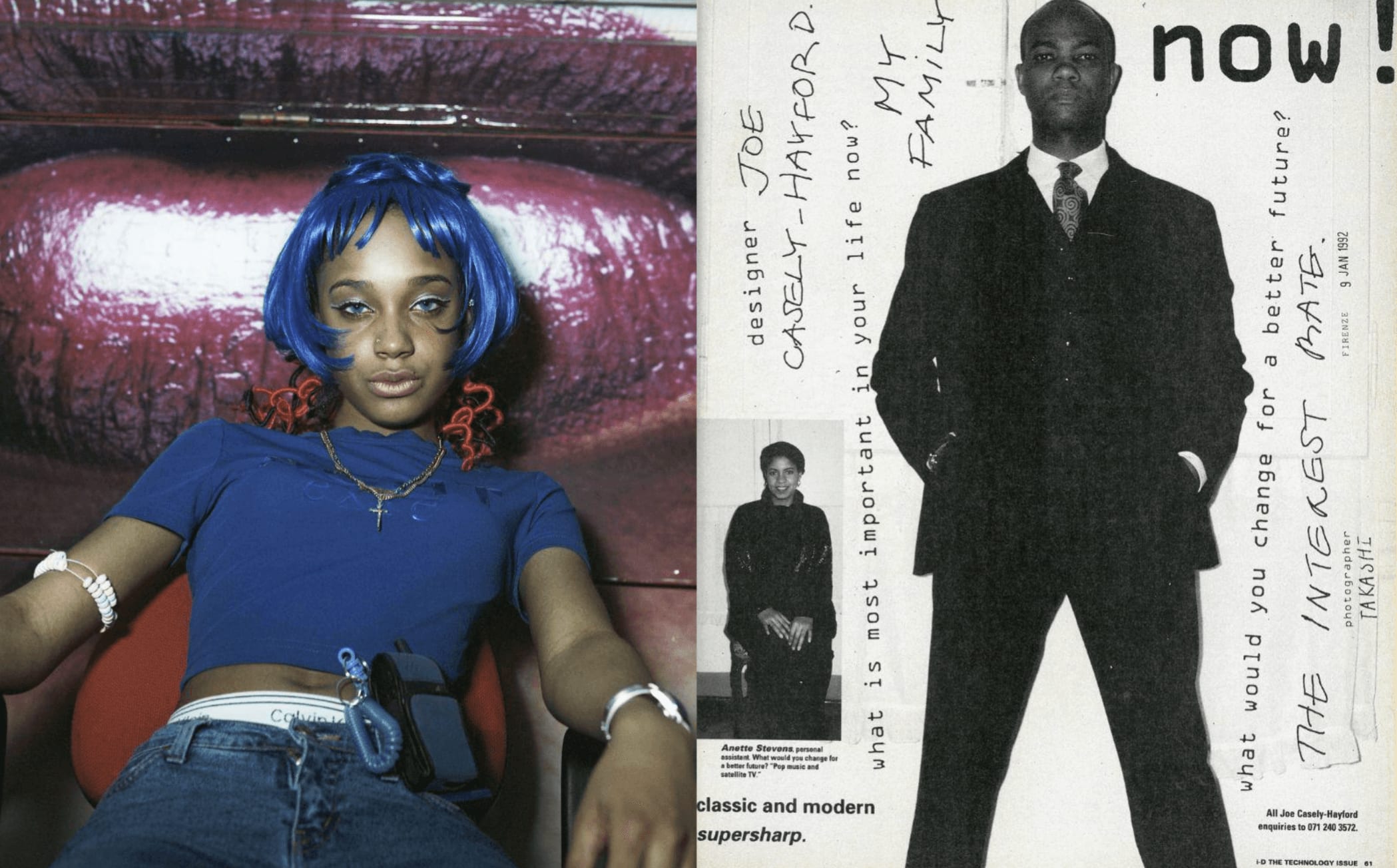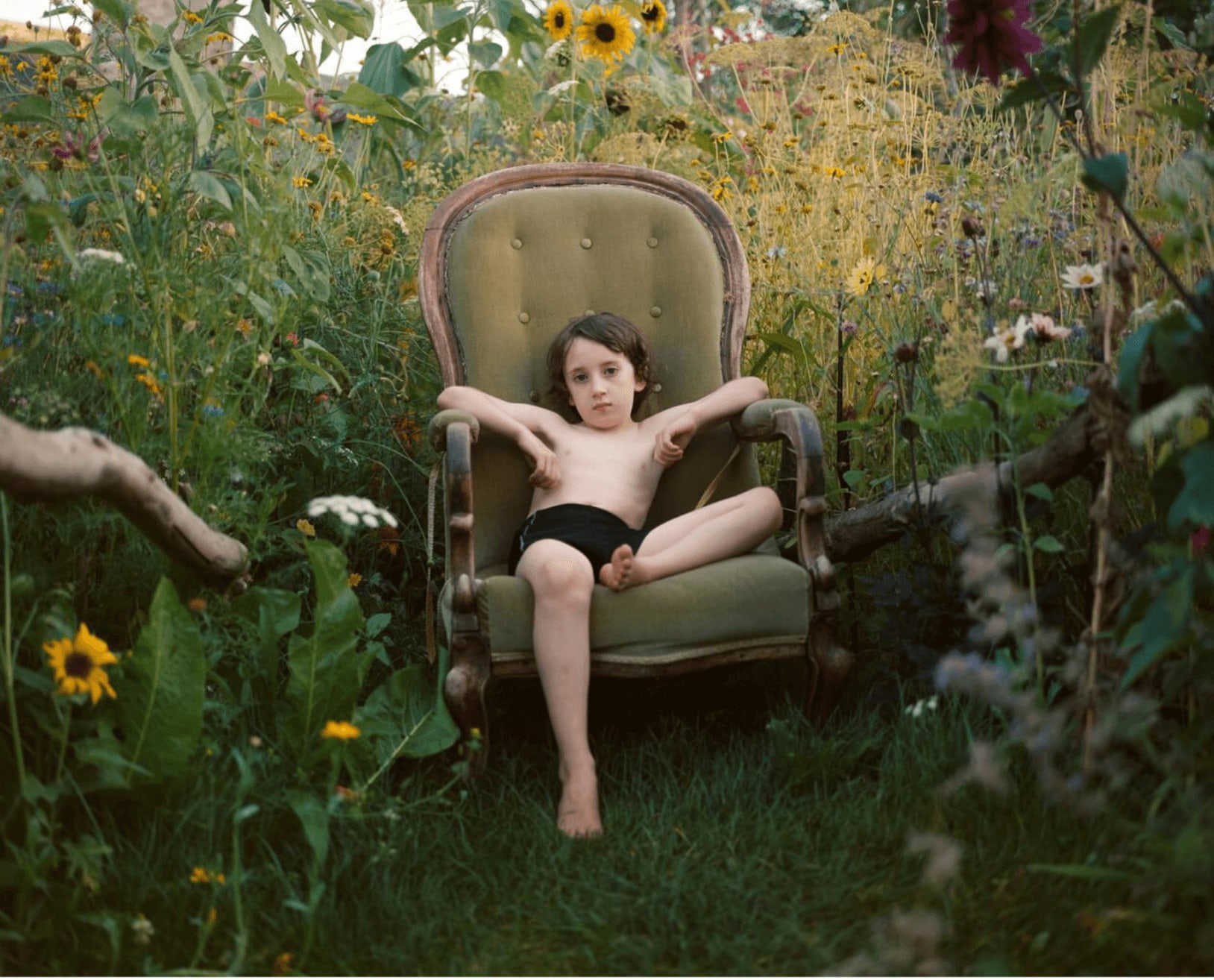Images of Indigenous Brazilians showing resistance
Photographer Fernanda Liberti's acclaimed series Dancing with the Tupinambá focuses on a community’s enduring fight to preserve their culture
Photographer Fernanda Liberti's acclaimed series Dancing with the Tupinambá focuses on a community’s enduring fight to preserve their culture
Welcome to Stop Scrolling, where each fortnight arts and culture writer Gilda Bruno will be bringing you a roundup of carefully curated exhibitions, art fairs and photo books to check out, as well as exclusive conversations with some of today's most exciting emerging artists.
This week, Bruno speaks with Brazilian visual artist and model Fernanda Liberti about Dancing with the Tupinambá - her intimate documentation of the Tupinambá native people - to explore how they are uniting to reclaim their history, heritage and territory from external attacks.**
The idea for Dancing with the Tupinambá, Fernanda Liberti’s award-winning photographic series came from a cape. It was 2018 when she stumbled across and instantly decided to turn the garment into the focus of her graduation project at the Royal Academy of Art. The design was created by the Tupinambá, one of the largest ethnic groups to inhabit Brazil prior to its Portuguese colonisation, between the 16th and the 17th century. The capes are an unparalleled work of art, an authentic example of Indigenous craftsmanship. Meticulously modelled out of bird feathers and vegetable fibres, these ancestral, sculpturesque mantles stand as an embodiment of the connection to the divine permeating the everyday experiences of the Tupinambá people.
Liberti noticed a significant lack of information on the history of this traditional garment, its symbolic function and uses. As she delved deeper, the visual artist discovered that the only 11 Tupinambá capes to have survived the test of time were all housed in European museums and collections, far away from the land where they originated. For the photographer, that realisation felt like an epiphany.
In 2021, she spoke to Glicéria Tupinambá, an Indigenous artist, activist and leader, who happens to be the first person to have successfully recreated the Tupinambá cape in present times. The artist invited Liberti to visit her in Serra do Padeiro, situated in the northeastern region of Bahia, Brazil, to document her and her family up close. “For many years, Indigenous people had to abdicate their community life in order to be respected in the contemporary capitalist world,” Liberti says, reflecting on the reason that prompted her to take portraits of Glicéria and her relatives in their home. “I wanted to capture them in their personal spaces to honour their roots and culture, because as Glicéria’s brother Cacique Babau once told me, ‘We Tupinambá have learned everything about the modern world and how to live in it, but others still don’t know anything about ours.’” She adds.
On the eve of the British Journal of Photography’s Portrait of Humanity Vol. 5 series, in which she was one of the winners, woo speaks to Fernanda Liberti about the making of Dancing with the Tupinambá, its contribution to the repatriation of artefacts belonging to Brazil’s indigenous people, and how this series sowed the seeds of her most personal project to date.

Congratulations on winning! How do photography, filmmaking, collage and fashion contribute to defining your experience of self-expression?
Fernanda Liberti: Creativity means everything to me. I draw inspiration from the most disparate things, from a street mural to a facial expression, a restaurant menu, a song or a feeling. I collect found objects, curating my little web of treasures. Even when I was forced to take up random jobs to support myself at the beginning of my creative career, I looked for art and beauty in everything. I knew one day I would be an artist. I have always loved to explore different mediums and ways of creating, and being an ADHD double gemini, it is part of me to do many things at once. Photography, filmmaking, collage and fashion are tools I use to spread messages and reach different people. They allow me to broaden my horizons and interests. Being a multimedia creative means that every aspect of your practice enhances, or complements, the other, which is something I love about it.
Dancing with the Tupinambá is the body of work with which you graduated from your Photography MA at London’s Royal College of Art (2022). What sparked your interest in this story?
Fernanda Liberti: It was through reading an article about Brazilian artefacts that I became familiar with the Tupinambá mantle: an ancestral, feathered cape that used to be worn by this specific Indigenous community in Brazil which, due to colonialism, could no longer be found in the country. I was surprised to realise that there wasn’t much information about it; even running a Google search would only lead to a handful of results. When I applied for a Photography MA at the Royal College of Art a few months later, I knew exactly what I would devote myself to during my time there. My goal was to make the repatriation and museological preservation of the mantles a reality. Since the beginning of the project, I zoomed in on the perspective of the Tupinambá today, striving to render what the physical absence of this garment means to them.


Comprising a collection of photographs and a short film, the project saw you collaborate with Indigenous artist, activist and leader Glicéria Tupinambá - one of the protagonists of the series. How did you first come in contact with Glicéria and her work?
Fernanda Liberti: I stalked her [laughs]. I needed to find a way of gathering more insights on the mantle, so I asked some of my friends who have links to the Indigenous movement in Brazil to put me in touch with the Tupinambá community, but it didn’t work out. Then one day in 2020, an online exhibition on Glicéria’s work - the first person to recreate the feathered cape in centuries - finally popped up on Google. I knew that she was pretty well-known, that she had spoken at the United Nations and had a picture with Luiz Inácio Lula da Silva, our current president, all of which led me to think I was never going to be able to team up with her. Instead of giving up, I kept on trying to get in touch with her. At some point, I found Daniela Alarcon’s contact through a hashtag on Instagram. She had written a book with Glicéria so, having pleaded my case with a gigantic message, I eventually managed to reach out to her directly. Without Glicéria, this project wouldn’t exist: having the pleasure of listening to her, let alone working and travelling together, has been an incredible honour.
Indigenous communities are widely underrepresented in the media. What principles guided the shooting process of this story? What influence did Glicéria have on its end result?
Fernanda Liberti: In one of our earliest conversations in May 2021, Glicéria asked me bluntly, “what do you want from me?” I told her that, besides photographing her, I wanted to be her ally, aiding her work and research. After hearing my answer, she asked me to visit her right away. Our creative collaboration reflects the way Glicéria wants the world to perceive her, her community and mission. My aim was to understand how to best use my voice to amplify hers, rather than speaking on her behalf. As there were no official accounts detailing the connection between the female Tupinambá community and the cape - all documents related to it were written by white European men in the 1500s - we wanted the series to spotlight women and their relationship to it. On our first real encounter, I gave Glicéria a book with an image of a woman wearing the mantle. On a recent visit we paid to the Oxford University Library, we found another one. Just like she skillfully worked the threads of the cape breathing new life into its long-lasting tradition, Glicéria has also woven a net of friends, allies, researchers and curators intent on collaborating to protect its endangered heritage.

Dancing with the Tupinambá was photographed in Serra do Padeiro, south Bahia. What were your earliest impressions of this region?
Fernanda Liberti: When Glicéria invited me to go see her, I dragged two of my best friends on an impromptu road trip to Serra do Padeiro, which I had never visited before. At first, I thought the series was only going to be about the mantle. Once there, what got me was the family love and empathy. I remember the first words Glicéria said to me when we arrived at her mother’s house were, “now you are at home”, and I really was. The images from the series were shot during my first two visits there, so they show my early impressions and focus well. The first visit had a stronger focus on the cape, the second coincided with the Tupinambá’s three-day-long New Year’s party in January, one of the most beautiful festivities I have ever attended. My favourite memory from it is waking up early, going to Dona Maria’s (Glicéria’s mother’s) house for breakfast and listening to everyone gossiping and laughing. The people of Serra do Padeiro have such a loving and peaceful nature.
What has been the highlight of this work for you?
Fernanda Liberti: The fact that the first Tupinambá mantle will finally be returned by Copenhagen’s Nationalmuseet to the National Museum of Brazil in Rio de Janeiro by the end of 2023 is a success that shows the relevance of this series. There are many more Tupinambá objects we don’t know of stored in the collections of European institutions and museums. We are currently working on a feature film about it, so the search never ends. Working with Glicéria taught me about the importance of the land, family, heritage and our ancestors, who live around and within us. She encouraged me to look for the fragments that went lost in my family history: my paternal great-grandparents left Syria to go to Brazil and never went back. My great grandfather died with the wish of taking his children to see his motherland, to return home. As my grandmother died and her siblings reached their elder days, the dream stayed unfulfilled. My new project will start from my family archive to expand into today’s world and sew the gap between seemingly unrelated people, countries and moments in time.
Fernanda Liberti’s Dancing with the Tupinambá is open at Belfast Exposed, Belfast, through 23 September
Scroll for an extra dose of art and culture news, curated for you by woo
When there’s so much to see and experience, it can be hard to choose where to spend your valuable time. Below, Bruno picks a selection of standout shows and culture events to explore in the coming weeks.
Artists For Morocco, Morocco Emergency Relief Print Sale

On 8 September, Morocco was hit by a catastrophic 6.8 magnitude earthquake which caused the loss of over 2,000 lives and left 1,404 people seriously injured. According to the World Health Organisation, the incident has already affected over 300,000 people. Composed of 26 Moroccan photographers and visual artists, both established and emerging, Artists For Morocco is a collective initiative set up by a trio of Morrocans: GQ Middle East editor-at-large Samira Larouci, photographer Anass Ouaziz and designer Ismail Elaaddioui, to aid humanitarian relief in support of the Moroccan population. With 25 images to choose from, this newly launched print sale will allow anyone to donate to Amal Women’s Training Center, a Marrakesh-based women’s charity delivering food to victims in need, and Rif Tribes Foundation, an NGO working to bring aid and support to the affected remote villages. Featured artists include Mous Lamrabat, Ilyes Griyeb, Ismail Zaidy, Fatimazohra Serri, Mohamed Amine Houari and Imane Djamil among many others.
The Missing Thread: Untold Stories of Black British Fashion, group show, Somerset House, London, 21 September - 7 January

Curated by the Black Orientated Legacy Development Agency (BOLD), The Missing Thread: Untold Stories of Black British Fashion is a new group exhibition celebrating the role played by Black British fashion trailblazers in revolutionising the field between 1970 and today. Looking at Black culture as a pivotal force of change within Britain’s critically acclaimed design history, the showcase explores the full spectrum of Black creativity - from music to photography, art and design - to pinpoint the artistic contaminations that have come to define the UK’s contemporary fashion landscape through the years. Among the highlights of the exhibition are a retrospective dedicated to the late Joe Casely-Hayford, which will open up the designer’s archive into a public installation in an unprecedented British survey of his work, and a series of exclusive commissions by new-vanguard Black designers Nicholas Daley, Bianca Saunders and Saul Nash.
Sarah Lucas, Happy Gas, solo show, Tate Modern, 28 September - 14 January

Thought-provoking, hilarious and uncanny, Sarah Lucas’ art is a feast for the senses. Having risen to fame in the 1990s thanks to her body-inspired soft sculptures, the British artist has never stopped turning ordinary objects into stimuli for conversations on sex, class and gender. Featuring installation, photography as well as her staple sculptural pieces, Happy Gas channels Lucas’ genius in all of its bold, uncompromising essence. Launching at London’s Tate Modern on 28 September and continuing through 14 January, the showcase is the ideal compromise for those wanting to spend an art-filled afternoon without taking themselves all too seriously.
Prix Pictet Human, group show, Victoria & Albert Museum, London, UK, 29 September-1 December

The 10th iteration of the Prix Pictet, the world’s leading prize for photography and sustainability, redirects the lens onto “the experiences, emotions, relationships and challenges that define our collective existence”. Titled Human, this year’s event will see the work of the 12 finalists Hoda Afshar, Gera Artemova, Ragnar Axelsson, Alessandro Cinque, Siân Davey, Gauri Gill, Michal Luczak, Yael Martinez, Richard Renaldi, Federico Rios Escobar, Vanessa Winship and Vasantha Yogananthan take over the photography section of London’s Victoria & Albert Museum between 29 September and December 1. Paying particular attention to what it means to be alive in an age of climate emergency, the shortlisted artworks invite us to reconnect with nature, ourselves and others, fostering social cohesion in the face of the ongoing environmental crisis. The winner of the latest edition of the Prix Pictet is set to be unveiled on the opening night of the group show. Stay tuned for more!



